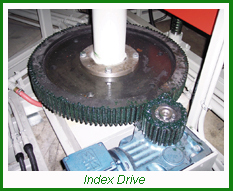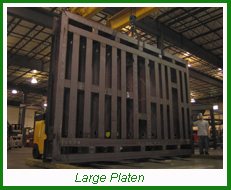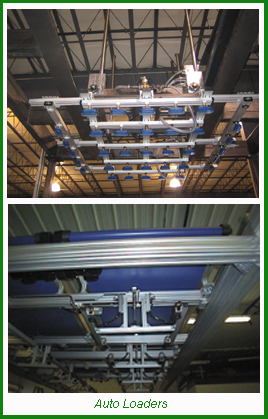|
THERMOFORMING: Advances in Thermoforming Machinery
As the Thermoforming Industry continues to grow,
and new challenges are presented, today’s thermoforming
machinery technology has become much
more advanced. The benefits to purchasing new machinery
will continue to outweigh those of used or retro-fitted equipment.
As the technology advancements have greatly
improved in all aspects of today’s machines, you simply cannot
cost-effectively bring an old machine up to today’s standards.
Below are some of the more recent advancements or
higher standards being implemented into today’s machinery.
These are just a taste of over 50 major improvements
and additional capabilities of machinery and process potential.
Some are more application-specific, but all can greatly
benefit today’s thermoformer. With more process control
than ever before, and more options and capabilities, new
machinery with its corresponding technology is truly
becoming one of the thermoformers greatest assets, and
certainly an engine that drives competition to the next level.
Controls
Machine controls are continually progressing. Proven
machine control software has now been implemented for
 over 20 years, allowing machine manufacturers to provide
an unlimited range of functions and capabilities all at the
palm of your hand. As more than 100 sheet fed thermoforming
machines are being built every year, more and
more ideas are requested and more and more improvements
are implemented.
over 20 years, allowing machine manufacturers to provide
an unlimited range of functions and capabilities all at the
palm of your hand. As more than 100 sheet fed thermoforming
machines are being built every year, more and
more ideas are requested and more and more improvements
are implemented.
The latest technology in computerized machine controls offers
huge benefits. Replacing relays and timers, manual buttons, and
switches with flat panel
touch screen interfaces
and innovative software
allows thermoformers the
ability to change every
machine parameter within
seconds. This eliminates
the manual process of setting
up different machine
sequences, adjusting limit
switches, opening and
closing valves, setting
oven heat configurations,
setting pressures and
even reading job setup
sheets. Not only can previously
programmed jobs be brought up and machine parameters
changed within seconds, new technology is also reducing initial
setup times and allowing the constant tweaking of jobs to
make them faster and more user-friendly.
Massive input and output diagnostic systems are now
standard, including oven zone burn out displays that allow
for the quickest trouble shooting and the least amount of
down time. Software is smarter, with built in alarms and
warnings that will notify the operator prior to potential
human error. Help files, job note sections, machine history
reports and statistical process control reports can be
viewed on screen or easily printed. Multi-level security
systems are built in to restrict or limit the control each
operator is granted. Phone modems for remote support
and program updates are standard, which greatly reduces
costly service technicians and machine down time. All this
comes as a result of ongoing R&D and ongoing feedback
from our market place. As most control systems and software
are now based on an “open architect” type of system,
if it is not already standard, it is usually just a matter
of what you want, how much it is worth to you, and
how quickly or easily it can be implemented.
Index Drives
A new standard has been made: nearly 90% of machines
being built today are constructed with motor driven index
 systems. Both shuttles and rotaries are being built with
index speeds measured from station to station in approximately
3 to 6 seconds, depending on overall machine size or
the application’s requirements. In the past, traditional
machines were designed using pneumatic systems ranging
anywhere from 8 to 14
seconds. These time
savings come right out
of the overall cycle
time. Not only does
this feature allow for
faster cycles, but
allows for better forming
of thinner gauge
materials and materials
that traditionally
cool too quickly. In addition, the costly expense of maintaining
older pneumatic systems is virtually eliminated. As
motor driven systems are smoother and much more accurate,
there is less wear and tear and less machine vibration.
systems. Both shuttles and rotaries are being built with
index speeds measured from station to station in approximately
3 to 6 seconds, depending on overall machine size or
the application’s requirements. In the past, traditional
machines were designed using pneumatic systems ranging
anywhere from 8 to 14
seconds. These time
savings come right out
of the overall cycle
time. Not only does
this feature allow for
faster cycles, but
allows for better forming
of thinner gauge
materials and materials
that traditionally
cool too quickly. In addition, the costly expense of maintaining
older pneumatic systems is virtually eliminated. As
motor driven systems are smoother and much more accurate,
there is less wear and tear and less machine vibration.
Clamp Frame
Clampframes have been evolving at record speeds over
the past few years, making more products capable of
being produced
in the thermoforming
process
whereas in the
past they may
not have been.
With over 20
application-specific
systems
that do everything
from being infinitely adjustable to tilting, bending,
slip sheeting and articulating, clampframes are helping to
reduce material thickness, reduce sheet sizes, induce sag,
reduce sag and even conform to the molds shape prior to
forming.
One of the most popular items available for every application
is adjustable clampframes. They have been one of
 the single hottest items to hit the thermoforming machinery
market. You no longer need to store and replace different
lengths of clampframe for the diverse sheet sizes
required to run different jobs. Adjustable clampframes
offer the ability to vary the length of the clamp frames
without having to add or remove clamp frame sections
from the machine, and with no tools required! Not only
can you change these frames in under 5 minutes, but you
can also document the position of these clamp frames and
easily return them to the exact position the next time the
product is run. Adjustable clampframes are continually
proving to save anywhere from 1-3 hours of downtime
(per mold changeover), depending on the type of machinery
or how many stations your equipment has.
the single hottest items to hit the thermoforming machinery
market. You no longer need to store and replace different
lengths of clampframe for the diverse sheet sizes
required to run different jobs. Adjustable clampframes
offer the ability to vary the length of the clamp frames
without having to add or remove clamp frame sections
from the machine, and with no tools required! Not only
can you change these frames in under 5 minutes, but you
can also document the position of these clamp frames and
easily return them to the exact position the next time the
product is run. Adjustable clampframes are continually
proving to save anywhere from 1-3 hours of downtime
(per mold changeover), depending on the type of machinery
or how many stations your equipment has.
In addition to speeding up your clampframe changeover
time, all of today’s clampframe designs are made to
keep sheet sizes to a minimum. Some of the older or poorly
designed clampframe systems require up to 2” of material
to be clamped in your frames. The standard of clamping
on 1/2” or less has been implemented for over a
decade but has now become standard!
Moving Ovens
As oven technology expands, more thermoforming
machines are being equipped with lower tracking oven systems.
As sheets are being heated, most common materials
begin to sag. As sag increases, the lower oven will keep an
equal distance away from the sheet until it has reached
optimal temperature, and will then index into the form station
to complete the process. This feature not only allows
for more precise control, but is a great means of saving
energy. For excessive sag materials, or large sheets that
sag due to size and weight, lower ovens no longer need to
be set at 20” or more away from the sheet-line when heating.
Traditional ovens are lowered below the maximum sag, which then requires the lower oven settings to be programmed
at extreme temperatures just to penetrate heat
into the sheet. Ovens can now be set much closer to the
sheet-line as they will move downward with the sag. When
this is implemented, typically oven settings can be at much
lower temperatures and still within the same heating time
- if not faster. This makes for much better use of the heat
and uses much less energy to produce the product.
Another moving oven feature that is gaining popularity
is referred to as an oven-over or shuttling oven.
Traditional U.S. style machines have fixed oven stations,
but more thermoformers are finding use and applications
for an oven that traverses into the form station. This feature
allows an upper oven half to actually shuttle out of
the oven station and into the form station. For very thin
materials or materials that cool too quickly, an oven-over
feature can follow the sheet into the form station to help
retain heat. Clients in point-of-purchase have found that
not moving the sheet but instead moving the oven half (or
halves) to the sheet allows them to hold tighter registration
when forming materials with screen printed graphics.
In addition to helping the forming process, it can also aid
in speeding up the pre-heating of molds rather than just
waiting on water or oil temperatures or using sheets of
plastic to heat the mold to optimal temperature.
Platens
The industry has raised the standards in new machine
form stations to accommodate some of the more engineered
thermoplastics being developed and the new
applications being introduced to our market. As the
motor driven platen has replaced nearly all pneumatic
platen drive systems, it easily has become today’s standard.
The motorized systems have proven to be more
accurate, more consistent, more controllable, faster and
unbelievably highly programmable. Not only has the bar
been raised to all motor driven platens, but to multiple
ways of driving them. Although the motor driven platen
system was traditionally based on a chain drive, numerous
different drive systems have been created to eliminate
chain slack and maintenance as well as to create more
precise forming stations. From Direct Drive Twin
Synchronized Motors to a single motor with multiple gear
box direct drives, a larger variety of application-specific
designs are available and have become standard.
Not only have drives been upgraded, but platen
strengths and weights have greatly increased to accommodate
some of the more challenging applications that
use higher pressures, twin sheet forming and even match
mold compression forming.
Platen speeds have also increased, by nearly 40%! The
need to travel rapidly into the heated sheet has become
more critical in today’s marketplace.
Even on the most basic machines, all platen positioning
and motor speeds are now controlled through the
machine’s control system. Gone are the time consuming
days of manually adjusting collars or limit switches. Today,
motor driven platens are equipped with encoders for fast
setups, repeatable speeds and precise positioning. The
encoders are interfaced into the control system with real
time graphic emulation of platen movement displayed on
screen. The platen settings are stored in the controller with
each job number for future recall. Encoder driven platens
no longer require homing or zeroing and the machine may
be turned off without losing platen home position.
Larger Machine Technology
Some of the most recent developments in large machine
construction have opened new doors for our industry. It is
 no longer being considered
a risk to purchase
and implement
larger machine
sizes. Previous
large machine technology
was minimal
due to the limited
demand, and machine
manufacturers
did not have enough
experience to costeffectively
design
and build them. With today’s technology advancements and
increasing market demand this has now changed.
no longer being considered
a risk to purchase
and implement
larger machine
sizes. Previous
large machine technology
was minimal
due to the limited
demand, and machine
manufacturers
did not have enough
experience to costeffectively
design
and build them. With today’s technology advancements and
increasing market demand this has now changed.
Over the past several years more machines are being
built to accommodate some of the largest molds or largest
thermoformed products ever manufactured in high volume quantities. Today, more innovative companies are discovering
the true advantage of larger machines and developing
parts that are larger than ever before. In addition to an
increasing demand for large parts, these large machines are
also being utilized to run multiple molds at once in order to
reduce costs and increase parts per hour. For example, one
of the higher volume thermoformed parts are pallets.
Traditional pallet machines ran 2 to 4 up, but as competition
grows companies are going larger with machines capable
of running 6 to 8 up. Some of the largest new thermoforming
machines manufactured over the past two years
are 16’ x 8’, 19’ x 10’, 14’ x 8’, and 21’ x 9’. Some of these
are straight vacuum formers, some pressure formers, and
one is even perhaps the largest twin sheet thermoforming
machine in the world with a 21’ x 8’ forming area.
Automation
Automation has increased its role in our process and is
being implemented more often than ever before. The
 increased demand for automation helps to reduce costs as
many systems have now become standard sub-assemblies
rather than “one-of” projects. With large sheets or hard to
handle sheets, automated systems are becoming necessary
to avoid the need for multiple loading and unloading
personnel. In competitive markets where machines are
running 6 to 8 up with fast cycle times, automation is also
necessary to help load the 6 to 8 sheets while simultaneously
unloading 6 to 8 finished parts.
increased demand for automation helps to reduce costs as
many systems have now become standard sub-assemblies
rather than “one-of” projects. With large sheets or hard to
handle sheets, automated systems are becoming necessary
to avoid the need for multiple loading and unloading
personnel. In competitive markets where machines are
running 6 to 8 up with fast cycle times, automation is also
necessary to help load the 6 to 8 sheets while simultaneously
unloading 6 to 8 finished parts.
Automation has also come into play due to the
increased demand for part inserts. These can be various
metals, foam or even
wood parts that are
inserted during the
thermoforming
process and become
part of the actual
finished product.
Typically these
inserts are placed
into a mold cavity in
the form station
before the sheet is
formed, or they are
placed between two
sheets in the twin
sheet forming
process. Little time
is given for these
inserts to be properly
placed manually,
and safety is always a concern when personnel are
required to enter a machine in production mode.
Automated robots and automated pick and place systems
are being incorporated to assist in this aspect to help
reduce labor costs, increase personnel safety, gain
repeatability and keep scrap rates to a minimum.
Summary
Today’s new thermoforming machines are available with
over 150 options, almost four times that of 5 years ago.
Some are application-specific, and some are quickly
becoming new industry standards. The large array of
options and capabilities now being offered certainly allows
thermoformers to focus in on features that will help them
create a unique machine specification, allowing them to
hold stronger competitive advantages. Almost every
machine being built today is specified around the thermoformers
core market, or specific applications and production
requirements. These new innovations are changing
the old mind set of buying all-purpose machines. The general
purpose machine has lost its place in the thermoforming
market. As competition grows, thermoformers
are becoming smarter and equipping themselves with new
technology in order to create their competitive edges.
Companies who are serious and are here to stay need
to invest in new technology. More than half of our industry
is operating machines that are over 20 years old, so
we do not need to ask why their profit margins continue
to decrease. The time has come to get rid of your old thermoforming
machine and buy new. Replace that typewriter
of yours, and see for yourself how much more efficient and
how much more profitable a computer really is!
Written by Michael P. Alongi, Sales Director for MAAC
Machinery Corp., manufacturers of a wide range of cutsheet
thermoforming machinery.
For more information, contact
MAAC Machinery Corp., 590 Tower Blvd., Carol Stream, IL
60188, 630-665-1700, Fax: 630-665-7799, E-mail: sales@
maacmachinery.com, Web: www.maacmachinery.com.
|